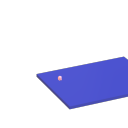@jameslo said:
@ddw_music If Pd's topological sort algorithm were smart enough to know when a change inside an abstraction did not change the sort outside the abstraction, then it would be an easy lift for it to detect that feedback to some abstraction (e.g. one with an [inlet~], an [outlet~], and no connections) does not produce a cycle. But the last I checked, that was not the case, so I would bet that when anything changes, the whole directed graph is resorted.
I guess the issue, then, is, if all the tilde objects get lifted into one flat list, then a change inside a subcanvas could get inserted in the midst of objects outside the canvas. In that case, it probably is necessary to walk the entire tree.
In the video, he starts off the sorting section by saying that canvases tell the DSP layer what has changed locally within the canvas, but then discusses the sorting flow when DSP gets turned on (which obviously has to start at the topmost canvas).
And then in g_canvas.c there are comments like
/* create a new "DSP graph" object to use in sorting this canvas.
If we aren't toplevel, there are already other dspcontexts around. */
so the data structure does seem to be split up by canvases.
It's not a crucial point -- just that, I'm expending a paper and wanted to contrast SC's per-SynthDef graph sorting vs Pd's seemingly global sorting. I'd rather not make a false claim.
Mailing list, I guess.
hjh


